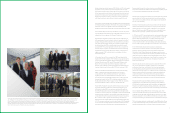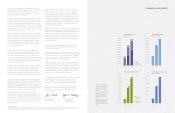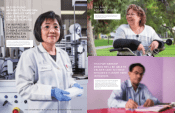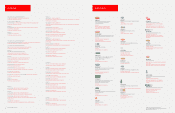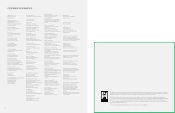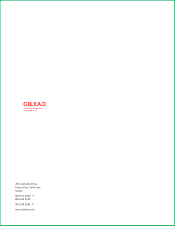Gilead Sciences 2015 Annual Report Download - page 3
Download and view the complete annual report
Please find page 3 of the 2015 Gilead Sciences annual report below. You can navigate through the pages in the report by either clicking on the pages listed below, or by using the keyword search tool below to find specific information within the annual report.
seen in clinical studies evaluating TAF-based regimens for HIV. In
January, Gilead submitted marketing applications in the United States
and European Union for TAF as a treatment of chronic hepatitis B.
Regulatory submissions are expected in Japan, Korea, Taiwan and
India this year and China in the first half of 2017.
Beyond TAF for HBV, several ongoing research programs are focused
on evaluating investigational therapies with finite duration of dosing to
achieve long-term viral suppression. The first is an immunomodulatory
approach where multiple programs are evaluating different ways to
activate the immune system to eliminate infected hepatocytes. The most
advanced is our TLR7 agonist, GS-9620, which is currently in two Phase 2
studies. Other approaches include the combination of novel direct acting
antivirals and agents that modulate cccDNA transcription.
In addition to treatments for chronic HBV and HCV infections, Gilead
is studying simtuzumab, a monoclonal antibody that inhibits LOXL2, in
nonalcoholic steatohepatitis (NASH) and primary sclerosing cholangitis.
Gilead’s GS-4997, an ASK-1 inhibitor, and GS-9674, an FXR agonist,
are also being evaluated in NASH. There are currently no approved
treatments for NASH, which is characterized by inflammation and
excessive fat accumulation in the liver that can lead to progressive
fibrosis, cirrhosis and liver failure.
Advances in Hematology/Oncology
Gilead continues to study Zydelig®
, a first-in-class PI3K inhibitor
approved in the United States and Europe, in several blood cancers.
Phase 3 study results show adding Zydelig to bendamustine and
rituximab in patients with relapsed chronic lymphocytic leukemia
provides statistically significant and clinically meaningful improvements
in progression-free and overall survival compared to bendamustine and
rituximab alone. Supplemental regulatory filings are planned in 2016
to include these important new data.
Gilead also is exploring novel combinations of investigational therapies
for a range of cancers, including four classes of kinase inhibitors—PI3K,
SYK, JAK and BTK—that each target different signaling pathways.
In addition, Gilead is developing investigational therapies in solid
tumors, including the initiation of a Phase 3 clinical trial of GS-5745,
an anti-MMP9 monoclonal antibody, in patients with gastric cancer.
Progress in Cardiovascular and Inflammatory Diseases
In October, the FDA approved a combination of ambrisentan, approved
as Letairis®
, and tadalafil for the treatment of pulmonary arterial
hypertension (PAH). The approval was based on data from the Phase 3
AMBITION study that showed patients who received ambrisentan and
tadalafil upfront were less likely to experience disease progression or be
hospitalized due to worsening of PAH—and also had more improvement
in exercise ability—than patients receiving either therapy alone.
In December, Gilead and Galapagos NV announced that the
companies entered into a global partnership for the development and
commercialization of filgotinib for rheumatoid arthritis (RA) and other
inflammatory diseases. Phase 2 trial data show that filgotinib, a JAK1
selective inhibitor, has the potential to be an effective and well-tolerated
oral therapy for patients with RA and Crohn’s disease. Phase 3 studies
will begin in 2016.
Improving Access Around the World
Gilead believes medicines should be accessible to all people who
need them, regardless of where they live or what resources they have.
We have increased the number of people receiving our antiretroviral
therapies in resource-limited countries from fewer than 30,000 people
in 2006 to more than 8.7 million in 2015. More than half of people now
treated for HIV in the developing world receive Gilead medicines. This
accomplishment is the result of a comprehensive approach to access,
including deeply discounted pricing of branded medicines and licensing
partnerships with generic manufacturers to produce high-quality,
low-cost versions of our medicines.
We also recognize the urgent need to address emerging diseases, such
as Ebola, that have a disproportionate impact on the developing world.
Gilead is working with collaborators to advance development of GS-5734,
an experimental compound that has shown promise as a potential
treatment for Ebola. Data from pre-clinical studies in animals has shown
that GS-5734 offered 100 percent survival in animals treated up to three
days after exposure to the virus. Two Phase 1 trials are now underway in
healthy adult volunteers.
Focusing on Our Communities
Collaborations within the biopharmaceutical industry and in the
communities in which we operate enhance our ability to improve the
continuum of care for patients.
In 2015, Gilead donated almost $500 million to organizations around the
world that are working to improve the lives of people with life-threatening
diseases. Gilead was also named the top corporate funder of HIV/AIDS
programs worldwide in 2014—and the second-largest HIV philanthropic
funder overall—by Funders Concerned About AIDS.
While the core of Gilead’s work is to develop life-saving medicines for
patients worldwide, we are also thinking about how to accomplish this in
the most environmentally conscious way. To that end, Gilead published its
first Sustainability Report in 2015, describing efforts to foster a culture of
sustainability across the company’s worldwide sites. Every sustainability
program Gilead creates is designed to be flexible and responsive to the
needs of the local communities where we live and work.
In Closing
2015 marked another extraordinary year for Gilead. While the company’s
portfolio has grown to 21 products and the pipeline continues to
be robust, there is much more to accomplish and many significant
opportunities to bring new medicines to patients around the world.
Thank you to our shareholders for your continued support, Board of
Directors for your counsel, and dedicated employees for your daily
efforts and hard work. We look forward to updating you on Gilead’s
continued progress.
John C. Martin, PhD John F. Milligan, PhD
Executive Chairman President and
Chief Executive Officer
Forward-Looking Statement
This Annual Report includes forward-looking statements regarding our clinical studies and product candidates, including the anticipated timing and achievement of certain development milestones, regulatory filings and
launches. Such statements are predictions and involve risks and uncertainties such that actual results may differ materially. Please refer to Gilead’s Annual Report on Form 10-K for the year ended December 31, 2015
attached to this report for the risks and uncertainties affecting Gilead’s business. Gilead disclaims any obligation to update any forward-looking statements in this report.
PRODUCT SALES
($ IN MILLIONS)
13 14 15
$ 33,000 –
$ 30,250 –
$ 27,500 –
$ 24,750 –
$ 22,000 –
$ 19,250 –
$ 16,500 –
$ 13,750 –
$ 11,000 –
$ 8,250 –
$ 5,500 –
$ 2,750 –
$ 0 –
$ 33,000 –
$ 30,250 –
$ 27,500 –
$ 24,750 –
$ 22,000 –
$ 19,250 –
$ 16,500 –
$ 13,750 –
$ 11,000 –
$ 8,250 –
$ 5,500 –
$ 2,750 –
$ 0 –
HCV
Products
HIV and other
Antiviral Products
Other Products
OPERATING CASH FLOW
($ IN MILLIONS)
$ 21,000 –
$ 18,000 –
$ 15,000 –
$ 12,000 –
$ 9,000 –
$ 6,000 –
$ 3,000 –
$ 0 –
13 14 15
TOTAL REVENUES
($ IN MILLIONS)
13 14 15
EARNINGS PER SHARE
13 14 15
GAAP Diluted
Earnings
Per Share
Non-GAAP
Diluted Earnings
Per Share
$ 13.00 –
$ 12.00 –
$ 11.00 –
$ 10.00 –
$ 9.00 –
$ 8.00 –
$ 7. 00 –
$ 6.00 –
$ 5.00 –
$ 4.00 –
$ 3.00 –
$ 2.00 –
$ 1.00 –
$ 0 –
• Non-GAAP diluted earnings per
share for 2013 exclude after-tax
acquisition-related and other
expenses of $0.11 and stock-
based compensation expenses
of $0.11.
• Non-GAAP diluted earnings per
share for 2014 exclude after-tax
acquisition-related and other
expenses of $0.55 and stock-
based compensation expenses
of $0.18.
• Non-GAAP diluted earnings per
share for 2015 exclude after-tax
acquisition-related and other
expenses of $0.53 and stock-
based compensation expenses
of $0.17.
FINANCIAL HIGHLIGHTS
32


